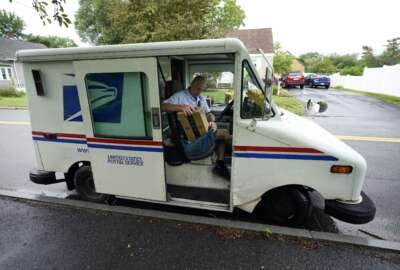

The Postal Service’s operational changes in recent years aren’t putting rural areas at a disadvantage when it comes to on-time delivery, according to a rece...
The Postal Service’s operational changes in recent years aren’t putting rural areas at a disadvantage when it comes to on-time delivery, according to a recent watchdog report.
The Government Accountability Office, in a report released Thursday, found few significant differences between the on-time performance in rural areas and urban areas.
GAO flagged eight out of 50 USPS districts — which generally fall along state lines — where there was a 5% or greater disparity in on-time delivery between rural and urban delivery areas.
The report found that among those districts with disparities, rural areas generally saw more on-time delivery than urban areas.
GAO found that rural on-time performance was higher than urban delivery in Georgia, Louisiana, New Jersey, Maryland, Delaware and northern Illinois.
Meanwhile, USPS’ on-performance in urban areas was higher than in rural areas of Massachusetts and Hawaii.
The GAO report shows that USPS, at least in the initial stages of implementation, hasn’t introduced service changes that have disproportionately impacted any particular demographic of the country.
USPS Vice President of Delivery Operations Angela Curtis told GAO that the report “validates expectations that there are few differences in service performance for rural and urban areas.”
“Through continuous improvement we will strive to provide optimum service to all of our customers in both rural and urban areas,” Curtis wrote. “These efforts will further advance our commitment to achieving our universal service mission, as we adopt the necessary changes under the Delivering for America Plan to achieve financial stability and service excellence.”
The GAO report covers USPS on-time performance data from October 2020 through December 2021 — the most recent data available to GAO, and a period of time that captures USPS performance during two year-end holiday seasons.
The watchdog based its findings on, on-time performance data for first-class mail, marketing mail, periodicals and most packages — the four largest USPS mail products by volume.
GAO found USPS has been tracking the overall performance metrics for on-time delivery, but hasn’t specifically focused on whether its operational changes are impacting any particular demographic of the country.
“Since implementation, USPS has not monitored effects on rural areas, although it continues to monitor service performance overall,” GAO wrote.
Among the changes studied by GAO, USPS in October 2021 implemented a slower delivery standard for nearly 40% of first-class mail.
By widening out first-class mail delivery to four and five-day delivery in some cases, USPS is looking to cut costs and provide a more consistent level of service — a metric USPS management believes its customers value more than overall speed.
USPS, as part of this plan, proposed it would save money by moving more mail through its ground transportation network and less through contracted air delivery services.
The Postal Regulatory Commission, however, warned USPS it didn’t see how the slower service standard would lead to “much improvement, if any” to its financial conditions, and wouldn’t immediately result in the agency reaching its on-time delivery goals.
While GAO found USPS isn’t putting rural or urban households at a disadvantage, the agency’s nationwide performance targets have been out of reach for years.
USPS did not meet any of its service performance targets for first-class mail between fiscal years 2015-2021.
Beyond a slower delivery standard for first-class mail, USPS is also putting several other operational changes into practice.
Those changes include a major network modernization initiative that’s expected to gain momentum later this year.
USPS since August 2021 has been planning to close and consolidate 16 mail-processing facilities, a process that GAO warns could affect both rural and urban postal services.
USPS since November 2021 has also sought to cut 50% of the work hours rural mail carriers spend on extra trips to deliver priority mail and priority mail express products.
USPS in October 2021 also began a rural route optimization initiative.
As part of this work, USPS is reviewing and streamlining the delivery sequence of rural routes nationwide, to ensure that each route is delivering mail more efficiently.
“Given that the many concurrent changes USPS is implementing may have evolving effects, the extent to which the changes affect rural areas in the future is unknown and warrants an additional review,” GAO wrote.
GAO said USPS’ recent history with other operational changes also raised concerns about any possible reduction in on-time delivery.
The USPS Office of Inspector General reported in 2020 that USPS had implemented operational changes in July and August 2020 without analyzing likely on-time service performance impacts, and that the changes resulted in a significant drop in the quality and timeliness of mail delivery.
GAO also found in 2015 that USPS operational changes in 2012 and 2013 led to concerns that rural areas were seeing a decline in on-time delivery.
USPS officials told GAO that the agency reports service performance by rural and urban areas to Congress when requested. USPS officials said they last briefed lawmakers on rural and urban on-time delivery at the national level in November 2021.
GAO conducted its latest report at the request of Sen. Maggie Hassan (D-N.H.), who raised concerns that recent USPS operational changes could disproportionately affect rural areas.
About 30% of USPS delivery points are considered rural. USPS delivers to more than 163 million addresses six days a week.
GAO has kept tabs on the financial viability of USPS on its list of high-risk federal programs since 2009.
“USPS has long faced financial challenges in meeting its universal postal service mission. Specifically, it cannot fund its current level of services and financial obligations from its revenues,” GAO wrote.
Copyright © 2024 Federal News Network. All rights reserved. This website is not intended for users located within the European Economic Area.
Jory Heckman is a reporter at Federal News Network covering U.S. Postal Service, IRS, big data and technology issues.
Follow @jheckmanWFED



